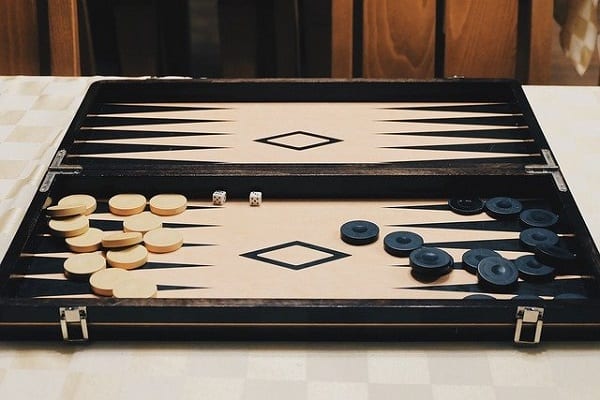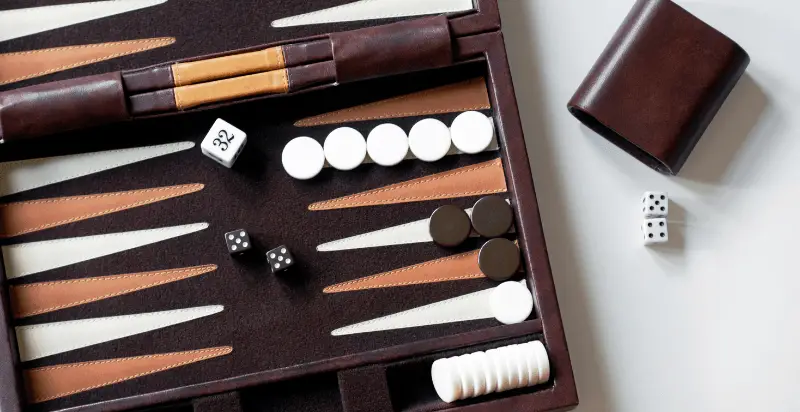If you’ve been thinking about playing a game of backgammon with a friend but you aren’t sure of the rules, not to worry - we’re here to tell you all you need to know about how to set up and play backgammon so you can have a great game night with friends and family!

There are a lot of different games that you can play on a backgammon board and they all have their own rules and starting positions.
Today, we’re going to be covering ‘standard backgammon’ which is the international version that’s played at live backgammon tournaments across the world, and it’s the version that’s played on most internet backgammon websites online.
Setting Up
Equipment
Backgammon, as you may have already guessed, is played on a board that is specifically designed for the game. The board consists of four tables of six thin triangles or points on every table. These points begin from the edges of the board that are nearest to the players, and they are directed inwards to create two rows of 12 points opposite each other.
In the middle there is a bar that divides the board, and the two tables on the one side are called the ‘inner’ or ‘home’ tables, with the others being known as the ‘outer’ tables.
Usually, the inner tables are positioned facing the biggest source of light.
On the table, you will have fifteen white disks, fifteen black disks, two dice, two dice shakers and also a doubling cube. What’s a doubling cube, you ask? This is a die that has the numbers 2, 4, 8, 16, 32 and 64 written on the 6 faces of the die.
The Objective and How to Prepare
Essentially, every player tries to move all of their pieces into the inner table that’s nearest to him (his home table) and once that has been achieved, they try to move the pieces off from the board. Whoever succeeds at this first is the player that wins the game.
With that being said, this is only really part of the game, because backgammon is designed to be played for stakes. So, ultimately, the underlying goal of backgammon is to win more stakes than your opponent does.
Playing the Game
When playing Backgammon, pieces are only able to move in one direction, and this is from the opponent’s inner table to the opponent’s outer table, then back through the player’s outer table and then finishing in the player’s inner table. The white pieces, on the other hand, move in a clockwise direction, while the black pieces move in an anti clockwise direction.
In order to start the game, every player needs to throw a single die. This will essentially decide which player goes first and what numbers are going to be played. If the numbers that come up are equal, then both of the players will keep rolling until they come up with different numbers.
The player that throws the highest number will at this point move their checkers in accordance to the numbers that are shown on both of the dice. After the first roll, the players will then throw two dice on alternate turns.
The dice roll will indicate how many points - also known as pips - the player needs to move their checkers. These checkers are always moved forward to a lower numbered point. There are a few rules to keep in mind.
Rules
Firstly, when you’re playing Backgammon, a checker can only be moved to an open point that is not already occupied by two or more opposing checkers.
In addition, the numbers that are on the two dice constitute separate moves. For instance, if a player ends up rolling a 5 and a 3 then they may move one checker five spaces into an open point and then move another checker three spaces to an open point. Alternatively, they may also choose to move one checker eight spaces to an open point, but this is only if the point that is either three or five spaces away is also open.
Any player that rolls doubles plays the numbers that are shown on the dice twice. This means that a roll consisting of 6 and 6 means that the player has four sixes to use in total, so they move pretty much any combination of checkers that they need to in order to complete this part of the requirement.
A player will need to use both numbers of a roll if it’s actually possible to do legally, or all four of the numbers of a double. If only one number can be played, the player will have to play that number.
Alternatively, if either number can be played but not both of them, then the player has to play the bigger number. If neither number is suitable the player will lose their turn. If you’re playing with doubles, when you can’t play any of the four numbers, the player needs to play as many numbers as they possibly can.
Stakes and Doubling
After the first turn at any point, any of the players are able to offer to double the stakes before they cast their dice. When the other player is presented with this offer, the other player can choose either to forfeit the game and the stakes that are currently present or they can accept the offer and also play doubles.
When the stake has been doubled once, it is only the player that accepted the most recent offer to double that is able to offer to re-double the offer. If this happens, then the other player is able to either forfeit the game or is able to accept the new double. This player, if they accept, can then offer the next double.
The doubling cube is what is used to record the current amount of stake.
On that note, however, while Backgammon is played for stakes that does not mean that it has to be for money. You are able to use other stakes, such as counters, beans or you can keep score using pen and paper.
Otherwise, you can completely eradicate the gambling element just by following the normal rules and you can ignore the doubling cube and the stakes. Generally though, a stake will be decided up front, whether you choose to opt for money or otherwise.
Bearing Off
Once a player has changed the position of all of the fifteen checkers into their home board, they can start bearing off. Essentially, a player bears off a checker by rolling a number that matches the point on which the checker is sitting. Then they remove that checker from their board. Essentially, if you roll a 4 for example you can remove a checker from the 4 point.
If you roll a number and there is currently no checker on that point on the board, the player has to make a legal move using a checker on a higher numbered point. If no checkers reside on higher numbered points, the player is allowed, and essentially required, to remove a checker on the higher point on which one of their checkers resides. A player doesn’t have to bear off if they are able to make a move that is otherwise legal.
In order to bear off, a player needs to have all of their active checkers in their home board. If a checker gets hit during the bear off process, then the player needs to bring that checker back onto their home board before they proceed with bearing off. The first player that bears off all of their fifteen checkers then wins the game.
Additional Optional Rules
There are also a couple of optional rules that some players choose to employ in their games of backgammon:
- Automatic Doubles: If two identical numbers end up being thrown on the very first roll, then the stakes are doubled. Then, the doubling cube is turned to 2 and remains in the middle. The players will generally agree to limit the amount of automatic doubles to just one per game.
- Beavers - If a player is doubled, they can immediately redouble (known as beaver) while they retain possession of the cube. The person who originally doubled can then have the option of accepting or refusing as they would with a normal double.
- The Jacoby Rule - Gammons and backgammons will count only as a single game if neither of the players has offered a double throughout the course of the game. This rule can speed up the play by getting rid of situations where a player would avoid doubling so they can play on for a gammon.
Conclusion
So those are some of the main rules of backgammon. Of course, the rules can often vary depending on how you’re playing and various other factors, but these are some general guidelines to go off from some of the globally accepted rules. If you’re just playing to have a little fun, you could always play around with whatever rules best suit you, or make some more challenging rules if you want to!

I’m Lia and I love playing games. I started this site to share things with friends and they encouraged me to post more and now I’m trying to share things with the world – indoor and outdoor sports, and board and bar games. I write about things like Bocce, Croquet, Billiards, Darts and other fun ways to enjoy time with your friends and family!


